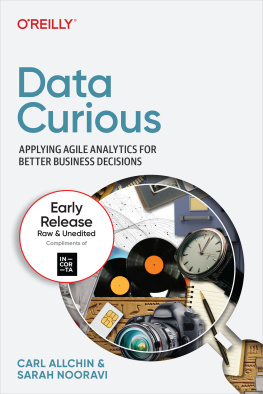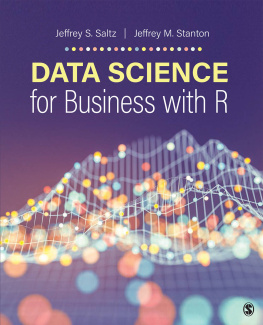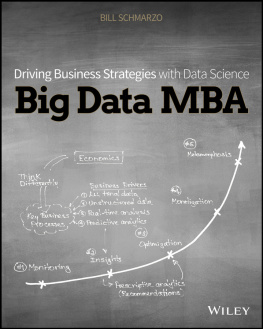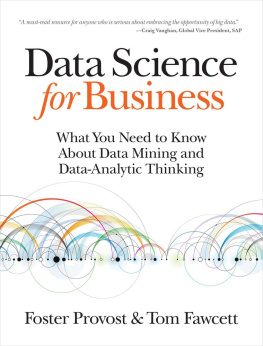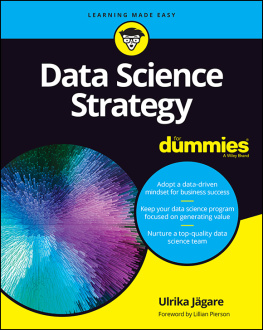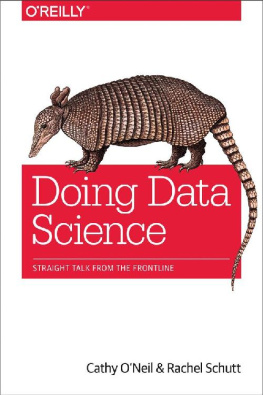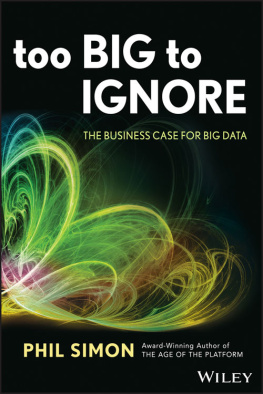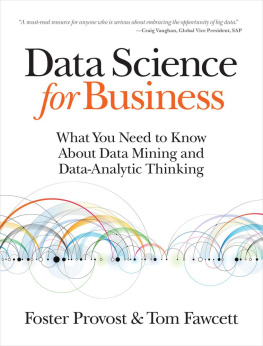Gerhard Svolba - Applying Data Science: Business Case Studies Using SAS
Here you can read online Gerhard Svolba - Applying Data Science: Business Case Studies Using SAS full text of the book (entire story) in english for free. Download pdf and epub, get meaning, cover and reviews about this ebook. year: 2017, publisher: SAS Institute, genre: Computer. Description of the work, (preface) as well as reviews are available. Best literature library LitArk.com created for fans of good reading and offers a wide selection of genres:
Romance novel
Science fiction
Adventure
Detective
Science
History
Home and family
Prose
Art
Politics
Computer
Non-fiction
Religion
Business
Children
Humor
Choose a favorite category and find really read worthwhile books. Enjoy immersion in the world of imagination, feel the emotions of the characters or learn something new for yourself, make an fascinating discovery.

- Book:Applying Data Science: Business Case Studies Using SAS
- Author:
- Publisher:SAS Institute
- Genre:
- Year:2017
- Rating:5 / 5
- Favourites:Add to favourites
- Your mark:
- 100
- 1
- 2
- 3
- 4
- 5
Applying Data Science: Business Case Studies Using SAS: summary, description and annotation
We offer to read an annotation, description, summary or preface (depends on what the author of the book "Applying Data Science: Business Case Studies Using SAS" wrote himself). If you haven't found the necessary information about the book — write in the comments, we will try to find it.
Applying Data Science: Business Case Studies Using SAS — read online for free the complete book (whole text) full work
Below is the text of the book, divided by pages. System saving the place of the last page read, allows you to conveniently read the book "Applying Data Science: Business Case Studies Using SAS" online for free, without having to search again every time where you left off. Put a bookmark, and you can go to the page where you finished reading at any time.
Font size:
Interval:
Bookmark:

Business Case Studies Using SAS
Gerhard Svolba
The correct bibliographic citation for this manual is as follows: Svolba, Gerhard. 2017. Applying Data Science: Business Case Studies Using SAS. Cary, NC: SAS Institute Inc.
Applying Data Science: Business Case Studies Using SAS
Copyright 2017, SAS Institute Inc., Cary, NC, USA
ISBN 978-1-60764-889-5 (Hard copy)
ISBN 978-1-63526-054-0 (EPUB)
ISBN 978-1-63526-055-7 (MOBI)
ISBN 978-1-63526-056-4 (PDF)
All Rights Reserved. Produced in the United States of America.
For a hard-copy book: No part of this publication may be reproduced, stored in a retrieval system, or transmitted, in any form or by any means, electronic, mechanical, photocopying, or otherwise, without the prior written permission of the publisher, SAS Institute Inc.
For a web download or e-book: Your use of this publication shall be governed by the terms established by the vendor at the time you acquire this publication.
The scanning, uploading, and distribution of this book via the Internet or any other means without the permission of the publisher is illegal and punishable by law. Please purchase only authorized electronic editions and do not participate in or encourage electronic piracy of copyrighted materials. Your support of others rights is appreciated.
U.S. Government License Rights; Restricted Rights: The Software and its documentation is commercial computer software developed at private expense and is provided with RESTRICTED RIGHTS to the United States Government. Use, duplication, or disclosure of the Software by the United States Government is subject to the license terms of this Agreement pursuant to, as applicable, FAR 12.212, DFAR 227.7202-1(a), DFAR 227.7202-3(a), and DFAR 227.7202-4, and, to the extent required under U.S. federal law, the minimum restricted rights as set out in FAR 52.227-19 (DEC 2007). If FAR 52.227-19 is applicable, this provision serves as notice under clause (c) thereof and no other notice is required to be affixed to the Software or documentation. The Governments rights in Software and documentation shall be only those set forth in this Agreement.
SAS Institute Inc., SAS Campus Drive, Cary, NC 27513-2414
March 2017
SAS and all other SAS Institute Inc. product or service names are registered trademarks or trademarks of SAS Institute Inc. in the USA and other countries. indicates USA registration.
Other brand and product names are trademarks of their respective companies.
SAS software may be provided with certain third-party software, including but not limited to open-source software, which is licensed under its applicable third-party software license agreement. For license information about third-party software distributed with SAS software, refer to http://support.sas.com/thirdpartylicenses.
Fr meine Eltern und meine Groeltern.
(To my parents and my grandparents)
In the late 1970s my grandmother from Burgenland came to visit us in Vienna for two weeks. I still remember that time. Every morning before I went to school, I prepared the DKT board game (which is a very popular equivalent to the Monopoly board game in Austria) to be able to start playing with her immediately when I came home from school. And she played with me the whole afternoon, every day. She lost every game, and it always ended with a huge debt amount for her. But she never complained or wanted to do anything else. Spending time with us, the children, was a priority for her. And that was always true for my parents and all my grandparents: We, the children, were always important to them.
I enjoyed having fun, listening to self-invented stories, being at the lake, inviting friends, constructing boats, and other stuff, but I also appreciated knowing that you have to work hard and be patient, modest, and persistent to achieve your goals. I learned very early that a happy life has many dimensions. Today I am aware that there are so many things from that time that I could take with me into my professional life and that made me successful.
Finishing this book beside a highly intensive full-time job as a SAS consultant and part-time lecturer at universities was a very hard trial for me. And I finally succeeded. The fact that this book ends with the simulation case study of the Monopoly board game is an essential piece that completes a comprehensive picture. It is my way of saying Thank You to my parents and my grandparents for so many things.
This book reflects my enthusiasm to use analytical and data science methods to solve business questions and to implement the solution using SAS.
Over the last few years I answered many business questions from our customers using analytical methods. For most of these questions, the application of analytical methods made a large difference. It allowed me to cover the business questions in a much more comprehensive, precise, and detailed way compared to the application of only graphical or descriptive methods.
That experience led me to write a book that illustrates and explains how data science methods and analytical methods can be applied in different business domains for different business questions.
The idea of this book is to provide a collection of case studies that have a business relationship and that show that analytical methods contribute value.
I also learned that many methods that are well established in a certain industry or business domain can be beneficial for other areas as well. One example is the application of survival analysis methods for employee headcount analysis, as shown in the first case study.
The first SAS program that I wrote dates back to 1991. Over the years I had the pleasure to combine my analytical knowledge and the power of the SAS Analytics Platform in many projects across different industries and business domains.
In these projects I experienced the importance of being able to combine advanced analytics with data management and reporting capabilities. It is one of the key paradigms of the SAS Analytics Platform to seamlessly provide this functionality.
This allows me, as a data scientist, to perform all my analysis tasks in a single environment.
Preparing data
Checking and improving data quality
Applying data science methods and generating results
Preparing and enhancing the results for further, more detailed analysis
Presenting the results in a format that is appropriate for the information consumer
My first two books [6 and 9] have a focus on the first two bullet points of this list. This book follows a case study approach and focuses on the application of data science methods, and the preparation, enhancement, and presentation of the results.
It illustrates the perfect fit of using the SAS Analytics Platform for the analysis of various business questions with data science methods.
This book is written for a variety of different persona groups and profiles.
Businesspeople can review the examples and see what can be achieved with analytical methods. They get insight into the power of analytics and the additional findings that can be generated by these methods. They might not study the SAS implementation and the code in much detail. They would rather hand over the implementation examples to their data scientist to give them a quick start to apply the methods.
Next pageFont size:
Interval:
Bookmark:
Similar books «Applying Data Science: Business Case Studies Using SAS»
Look at similar books to Applying Data Science: Business Case Studies Using SAS. We have selected literature similar in name and meaning in the hope of providing readers with more options to find new, interesting, not yet read works.
Discussion, reviews of the book Applying Data Science: Business Case Studies Using SAS and just readers' own opinions. Leave your comments, write what you think about the work, its meaning or the main characters. Specify what exactly you liked and what you didn't like, and why you think so.

